 Facebook
Facebook
 X
X
 Instagram
Instagram
 TikTok
TikTok
 Youtube
Youtube
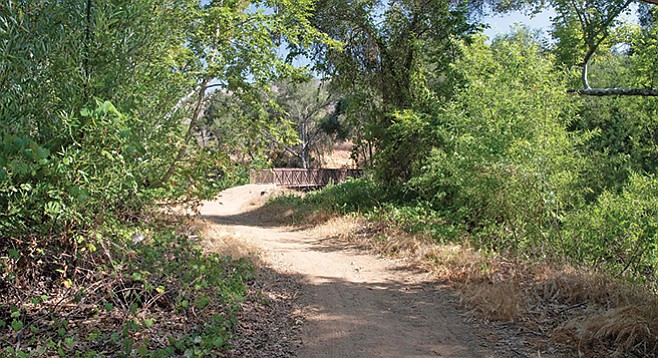
The trail is well marked and easily followed. One segment is a paved fire road, but mostly it is a wide dirt road. There are no challenging climbs or obstacles, but there is only intermittent shade, so bring plenty of water and snacks. Habitats on the trail include coastal sage scrub or chaparral with some oak forest and dense riparian habitats along with seasonal arrays of wildflowers. The views of the surrounding hills and of San Pasqual Agricultural Preserve are outstanding.
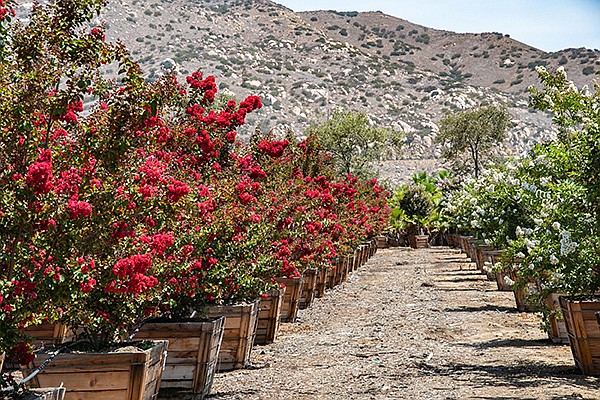
The Old Coach Trail begins at the southwestern corner of the Staging Area. For the first half mile, it is on an easement through a large nursery called “The Growing Grounds”, where you will see numerous ornamental trees in large boxes. Look for native species also, including blue Palo Verde and California sycamore.
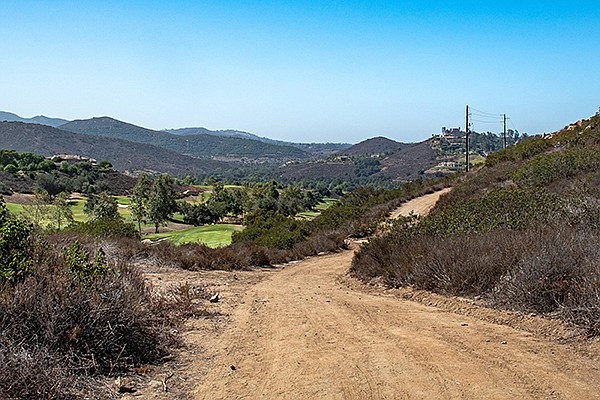
At 0.48 mile from the trailhead, you cross into Poway. The trail now begins ascending a paved fire road on the east-facing slope of a ridge above a rocky canyon. There are patches of oak forest along the intermittent stream below. The chaparral is fascinating even in dry years. In summer, the numerous laurel sumacs are either in flower or already forming seeds. Toyon, also common here, are in flower. Drought can particularly affect the occasional spiny redberries, which may not have any fruit, and the chalk dudleya, common on the embankment on the west side of the road, may appear to be barely surviving. But the views here are amazing, so be sure to look behind you north and east.
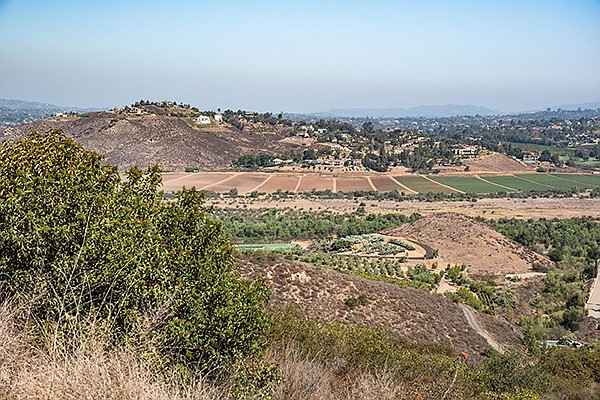
The fire road ends when the trail reaches and crosses Heritage Drive. There are several large homes, all on multi-acre lots with swimming pools, tennis courts, bright green lawns, and lush, non-native landscaping along Heritage Street.
Heritage Drive is an irregular circle with a shallow canyon bisecting it. After crossing the road, the trail follows a dirt road above an intermittent stream at the bottom of this canyon. The native vegetation here is a mixture of riparian, chaparral, and coastal sage scrub species. Toyon is in flower, as well as laurel sumac and mule-fat. The coyote and broom baccharis, common here, may bloom later in the summer or fall, along with Orcutt’s goldenbush.
After crossing the Heritage Drive circle, the trail turns right and follows Heritage Drive for a short distance, then crosses the road and begins the descent to Sycamore Creek. The trail now follows a power line service road, which may have been part of the original Old Coach Road. It descends 0.65 mile to Sycamore Creek, passing through coastal sage scrub where California buckwheat is nearly always in flower and California sagebrush is abundant. There is a golf course off to your left as you descend.
When you arrive at Sycamore Creek, you will find an abundance of huge coastal live oaks, arroyo willow, Goodding’s black willow, poison oak, and numerous other common riparian species. It is an exceptionally quiet, restful place to take a break. The bridge across the creek was newly built to replace one destroyed several years ago in a flash flood.
Shortly after leaving the bridge, you will come to the signed Lomas Verde Trail off to the right. It is an extension of a trail crossing the highlands to the west. It mainly goes through north Poway suburbs. For this hike, keep to the trail on the left, which is the Old Coach Trail. You now have about 1.5 miles to go to reach the Old Coach Trailhead and Staging Area near Espola Road. From this point to the Espola Road Staging Area, the trail is often oak shaded and nearly flat – a pleasant walk mostly in the shade.
On reaching Old Coach Road, you must cross to the east side of the road. The trail continues beside the road for about 0.2 mile, then splits with the trail to the left descending down nearer the streambed. Take the left branch and find the remains of an even older Old Coach Road that is now overgrown, giving you both relief from the noisy highway above and more shade. You must again cross the road when you are almost at the staging area.
The staging area has a picnic table but no shade, water or facilities. If you are concerned that a 7-mile hike may be more than you want to undertake, you could arrange to have a second car parked here or use a rideshare app to get back to Highland Valley Road. Otherwise, enjoy the great views on the way back!
OLD COACH TRAIL (North Poway)
Follow part of the early stagecoach line between Poway and Escondido.
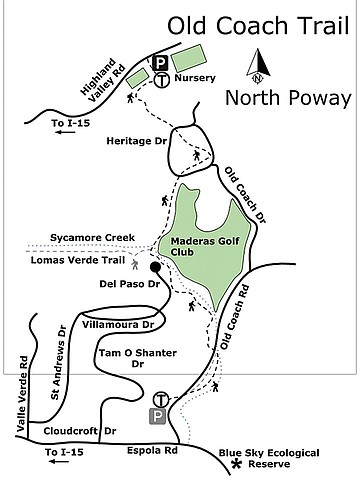
Driving directions: (North Poway) From I-15 north, take exit 26 for Pomerado Drive/Bernardo Drive. Then head east on Pomerado to Highland Valley Road, about 0.2 mile. Make a left on Highland Valley Road and continue 2.4 miles to the Staging Area, 14225 Highland Valley Road, on your right. Look for a sign proclaiming “The Growing Grounds,” with a smaller sign next to it for the Old Coach Staging Area on the right. There is adequate day parking, but the lot closes at 6 pm. No facilities or sources of drinking water. Hiking length: 7 miles out-and-back. Allow 3.5 hours. Difficulty: Moderately difficult with an elevation gain/loss of 2000 feet. Hikers, leashed dogs, bicyclists, and equestrians are allowed on the trail.


The trail is well marked and easily followed. One segment is a paved fire road, but mostly it is a wide dirt road. There are no challenging climbs or obstacles, but there is only intermittent shade, so bring plenty of water and snacks. Habitats on the trail include coastal sage scrub or chaparral with some oak forest and dense riparian habitats along with seasonal arrays of wildflowers. The views of the surrounding hills and of San Pasqual Agricultural Preserve are outstanding.

The Old Coach Trail begins at the southwestern corner of the Staging Area. For the first half mile, it is on an easement through a large nursery called “The Growing Grounds”, where you will see numerous ornamental trees in large boxes. Look for native species also, including blue Palo Verde and California sycamore.

At 0.48 mile from the trailhead, you cross into Poway. The trail now begins ascending a paved fire road on the east-facing slope of a ridge above a rocky canyon. There are patches of oak forest along the intermittent stream below. The chaparral is fascinating even in dry years. In summer, the numerous laurel sumacs are either in flower or already forming seeds. Toyon, also common here, are in flower. Drought can particularly affect the occasional spiny redberries, which may not have any fruit, and the chalk dudleya, common on the embankment on the west side of the road, may appear to be barely surviving. But the views here are amazing, so be sure to look behind you north and east.

The fire road ends when the trail reaches and crosses Heritage Drive. There are several large homes, all on multi-acre lots with swimming pools, tennis courts, bright green lawns, and lush, non-native landscaping along Heritage Street.
Heritage Drive is an irregular circle with a shallow canyon bisecting it. After crossing the road, the trail follows a dirt road above an intermittent stream at the bottom of this canyon. The native vegetation here is a mixture of riparian, chaparral, and coastal sage scrub species. Toyon is in flower, as well as laurel sumac and mule-fat. The coyote and broom baccharis, common here, may bloom later in the summer or fall, along with Orcutt’s goldenbush.
After crossing the Heritage Drive circle, the trail turns right and follows Heritage Drive for a short distance, then crosses the road and begins the descent to Sycamore Creek. The trail now follows a power line service road, which may have been part of the original Old Coach Road. It descends 0.65 mile to Sycamore Creek, passing through coastal sage scrub where California buckwheat is nearly always in flower and California sagebrush is abundant. There is a golf course off to your left as you descend.
When you arrive at Sycamore Creek, you will find an abundance of huge coastal live oaks, arroyo willow, Goodding’s black willow, poison oak, and numerous other common riparian species. It is an exceptionally quiet, restful place to take a break. The bridge across the creek was newly built to replace one destroyed several years ago in a flash flood.
Shortly after leaving the bridge, you will come to the signed Lomas Verde Trail off to the right. It is an extension of a trail crossing the highlands to the west. It mainly goes through north Poway suburbs. For this hike, keep to the trail on the left, which is the Old Coach Trail. You now have about 1.5 miles to go to reach the Old Coach Trailhead and Staging Area near Espola Road. From this point to the Espola Road Staging Area, the trail is often oak shaded and nearly flat – a pleasant walk mostly in the shade.
On reaching Old Coach Road, you must cross to the east side of the road. The trail continues beside the road for about 0.2 mile, then splits with the trail to the left descending down nearer the streambed. Take the left branch and find the remains of an even older Old Coach Road that is now overgrown, giving you both relief from the noisy highway above and more shade. You must again cross the road when you are almost at the staging area.
The staging area has a picnic table but no shade, water or facilities. If you are concerned that a 7-mile hike may be more than you want to undertake, you could arrange to have a second car parked here or use a rideshare app to get back to Highland Valley Road. Otherwise, enjoy the great views on the way back!
OLD COACH TRAIL (North Poway)
Follow part of the early stagecoach line between Poway and Escondido.

Driving directions: (North Poway) From I-15 north, take exit 26 for Pomerado Drive/Bernardo Drive. Then head east on Pomerado to Highland Valley Road, about 0.2 mile. Make a left on Highland Valley Road and continue 2.4 miles to the Staging Area, 14225 Highland Valley Road, on your right. Look for a sign proclaiming “The Growing Grounds,” with a smaller sign next to it for the Old Coach Staging Area on the right. There is adequate day parking, but the lot closes at 6 pm. No facilities or sources of drinking water. Hiking length: 7 miles out-and-back. Allow 3.5 hours. Difficulty: Moderately difficult with an elevation gain/loss of 2000 feet. Hikers, leashed dogs, bicyclists, and equestrians are allowed on the trail.
Comments